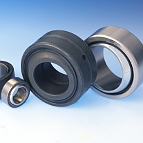
Dynamic Load Rating for Spherical Plain Bearings
Dynamic load rating is used for calculations when the spherical plain bearing is subjected to dynamic stress.
It represents the load, constant in magnitude and direction, under which a basic rating service life, expressed as a sliding distance, will be attained for continuous oscillating movement at a defined sliding velocity and at room temperature.
This rating presupposes that the load acting on radial and angular spherical plain bearings and on rod ends is purely radial and that the load acting on spherical plain thrust bearings is purely axial and acts centrically.
Dynamic stresses occur when tilting, oscillatory or rotational movements are made under load as well as micro-sliding movements under alternating loads, e.g. resulting from vibration, or loads which alternate at high frequency. The various types of dynamic stress often occur in combination.
The values of load ratings are always dependent on the definition used. It is therefore not always possible to make direct comparisons with load ratings published by other manufactures.
Static Load Rating for Spherical Plain Bearings
Static load rating is used when spherical plain bearings remain stationary under load (or make occasional alignment movements) and it should also be considered when dynamically loaded bearings are subjected to heavy shock loads.
The static load rating represents the load which can be taken by a spherical plain bearing when static contact stress of bearing contact surface reaches the material stress limit.
It is valid at room temperature and it is presupposed that the surrounding components prevent deformation of the bearing. At higher temperature, the static load rating must be multiplied by a temperature factor, depend on the sliding contact surface combination.
The temperature factor is the same as for dynamically stressed bearing. It is also necessary to take into consideration the permissible temperature range for the various sliding contact surface combinations.
For rod ends, it is the strength of the rod end housing under stationary load which is considered. The rod end static load ratings give a safety factor of 1.2 times the tensile strength of the rod end housing material.
Looking for more information about static and dynamic load ratings or spherical plain bearings? Our team of bearing experts provide engineering consulting and design and are happy to help – contact them here.

